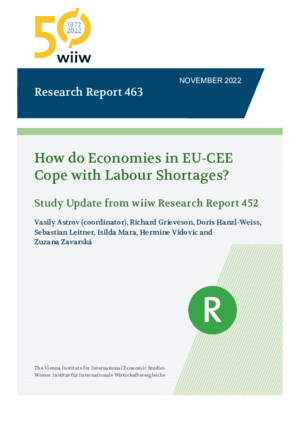How do Economies in EU-CEE Cope with Labour Shortages?
Vasily Astrov, Richard Grieveson, Doris Hanzl-Weiss, Sebastian Leitner, Isilda Mara, Hermine Vidovic and Zuzana Zavarská
wiiw Research Report No. 463, November 2022
Study Update from wiiw Research Report 452
77 pages including 8 Tables and 41 Figures
The EU member states in Central and Eastern Europe (EU-CEE) have been experiencing increasing labour shortages, which only briefly subsided in the wake of the COVID-19 pandemic. Ongoing demographic decline suggests that labour shortages will only get stronger over time. As a result, the bargaining power of labour has increased, wages have been generally rising ahead of labour productivity, and industrial action (strikes) – the level of which has remained low in recent decades – has emerged in some instances. In the face of labour and skill shortages, people have been investing in education. The share of employees with tertiary education has increased, and vocational training has gained in importance, although active labour market policies have been used only selectively. Employers have increasingly been investing in fixed assets, especially in manufacturing, and the degree of robotisation has risen strongly. Despite domestic concerns that automation would generate massive job losses, our findings suggest that capital deepening has taken place faster where labour was in higher demand. Thus, labour was not substituted with capital, but rather the complementary effect prevailed. Employment actually increased in EU-CEE over the past two decades – despite the shrinking working-age population. Employers could hire not only the formerly unemployed, but also the formerly inactive, and used the relaxed immigration policies to attract foreign workers, especially from Ukraine and the Western Balkans. Czechia, Hungary, Slovenia and Slovakia and most recently Poland have become net receivers of migrants, while in Bulgaria immigration largely compensates for the natives who go abroad. However, immigration from non-European countries as a general solution to the problem of labour shortages in the region is highly problematic in the current domestic political context. Overall, both our findings for the EU-CEE region over recent years and the experience of Western Europe during the ‘golden age’ (1950-1973) suggest that labour shortages are not in themselves an obstacle to rapid structural change and income growth. However, for such an economic model to be sustainable, more active government policies will be needed, such as greater public investment in education and training, higher minimum wages in order to encourage automation, and more extensive welfare networks in order to deal with the possible negative short-run side-effects of automation.
Reference to wiiw databases: wiiw Annual Database
Keywords: labour shortages, trade unions, migration policy, active labour market policy, investment, vocational training, ‘golden age’, populism
JEL classification: J21, J23, J24, J31, J52, J61, N14, N34
Countries covered: EU-CEE
Research Areas: Labour, Migration and Income Distribution
